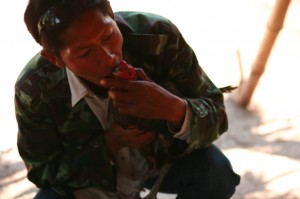Media coverage of pandemics across the Mekong region has been a learning curve for journalists, as they struggle to understand hitherto unknown viruses, keep their audiences abreast of the latest public health emergencies and give them correct and preventive information.
H1N1, the latest virus to grab global headlines, was first detected in North America in April and then spread rapidly across the globe to Asia. 
In more recent times, research on how this story was reported across the Mekong region revealed a picture that was heartening to experts on public health information. “The H1N1 virus has received more coverage than other viruses,” Robert Kelly, regional representative for the Academy for Educational Development, told a session on reporting of cross-border health issues at the Mekong Media Forum on Dec. 11.
“But it is a double-edged sword,” he noted. “There were good opportunities to get key health messages out. But there was an inability to control the message.”
Particularly troubling was the contrast between stories and headlines in the region’s newspapers. “The content was good but the headlines were sensational,” he revealed.
The reportage on H1N1 and other viruses should convince journalists that health and science reporting requires caution and accuracy to avoid creating panic, Zhu Yan, senior editor of the national broadcaster China Central Television told the forum. “When it comes to scientific reporting, I ask journalists to be cautious.”
“We should report the disease, not promote the disease,” he said while describing errors made in the Chinese media during the early stages of the HIV pandemic. “We should inform the public, but not create fear.”
But countries like Laos also reflect a changing trend, one that has seen governments opening up to the media on the matter of H1N1, having learnt the lessons of the previous H5N1 virus, which swept through South-east Asia since the winter of 2003.
“In the past two years the health authorities have given us more support, holding weekly meetings, to ensure better reports,” said another panelist, Ounkeo Souksavanh, a radio broadcaster in the communist-ruled country. “In the past we didn’t get such support, when the H5N1 began.”
Yet the media in the landlocked country, which has a population scattered in remote rural villages in the hilly regions, are dealing with other challenges such as having to reach out vulnerable communities that live in inaccessible areas. “It is a challenge for the media in Laos to get access to rural people to inform them about what needs to be done in response to viruses,” revealed Ounkeo. “It was quite difficult to convince farmers who breed chickens to slaughter them to stop the spread of avian influenza (as H1N1 is also known).”
Avian influenza has infected 444 people and there have been 262 deaths, according to the World Health Organisation. Countries struck by this virus in the region with recorded human fatalities since late 2003 include Thailand, Vietnam, Laos, China, Cambodia and Indonesia.
Cases of H1N1, which is also called “swine flu” and spreads like a regular flu, have also been reported in China, Cambodia, Laos and Thailand. (MMMarkar)







